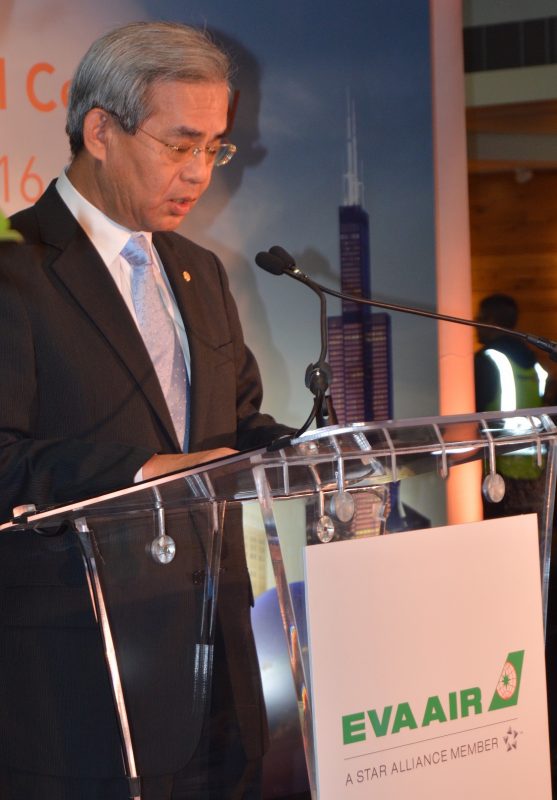On Wednesday, November 2, Taiwan’s EVA Air (BR) welcomed its first flight from Taipei to Chicago’s O‘Hare International Airport. With the inauguration of this route, the carrier now serves 8 destinations in North America, and the carrier’s President, Derek Chen, hosted a press interview session that helped to define EVA’s long-term strategy.
The discussion included three other EVA representatives – Albert Liao, EVP; Golden Kou, Public Affairs Spokesman; and George Chen, Executive VP, North America. The four of them contributed to the questions that were asked and as such, the replies are credited to EVA rather than a specific person.
RK: What percentage of BR’s total ASMs are generated to North America and will it continue to grow?
EVA: It currently stands at about 51%, up from 47% in 2012. We anticipate that future growth will come from additional flights at points currently served, rather than the addition of new destinations. At present, all of our flights between North America and Taipei depart around midnight with arrival in the early morning in Taipei. We have begun to introduce daylight departures at a number of our cities that would arrive in Taipei in the evening, feeding a different connecting bank. The first of these began in August 2016 from Los Angeles and New York. In 2017 similar service will begin from Seattle and San Francisco.
RK: What is the goal in doing so?
We plan to make our Taipei (TPE) hub a primary connection point between North America and Asia. Given the fact that our airline flies to 30 points in the PRC, we can offer travelers immediate onwards connections across China. In order to facilitate that growth there is an ongoing airport expansion at the Taipei hub, originally built for 32 million passengers annually, but now serving 38 million. Expanded and updated facilities are a key component of our strategy, making transit easier and enhancing the product.
RK: Aren’t there restrictions on transit traffic exiting the PRC?
EVA: Yes, only four origin cities in the PRC are open for onward transit via Taipei. But that applies only for travelers beginning their journey in the PRC. Tickets issued in the rest of the world, Asia, North America and Europe, have no such restriction, so inbound travelers can fully utilize our PRC network.
RK: One of the signature features of EVA Air is its Hello Kitty liveried aircraft sub-fleet. Where is that campaign going next?
EVA: The promotion, undertaken in conjunction with Sanrio, has proven to raise awareness of the airline in ways that have rarely been duplicated. While most of the Hello Kitty aircraft are Airbuses and operate in Asia, there is a ready audience in North America that would like to see the especially liveried B777-300s at more airports here. Currently Houston is the gateway served by a Hello Kitty aircraft but there is a strong demand and we may expand the number of North American destinations involved.
RK: You have new aircraft on order, how will they be deployed?
EVA: We are awaiting delivery of a new fleet of 787-9 and 10s, aircraft that will, because of their operating economics, make route expansion possible. However, the “workhorse” of the fleet remains the B-777-300. Our airline currently operates 29 with 7 more to be added, and this aircraft will continue to be the mainstay for North American service.
RK: Service to Europe is limited to only four cities and three of those flights include a stop in Bangkok, with only Paris being operated nonstop. Why?
EVA: European services to London, Amsterdam and Vienna all are routed via Bangkok where we have 5th Freedom rights. We are pleased with the traffic generated to and from Bangkok and have no plans to change the routing. Paris is served with nonstop flights and following the attacks last year, we saw a slight decline on that route—a phenomenon that is industry wide. However, things are slowly normalizing again.
RK: You are a member of Star alliance and yet only one of the European destinations (Vienna) is a Star partner hub. Any plans to change that?
EVA: At present, the bilateral with Germany allows only 7 weekly frequencies by Taiwanese carriers and those slots are currently used by China Airlines to Frankfurt. However, governmental discussions are underway and we are optimistic that additional slots will be authorized. When that happens, it is our intention to begin flights to Germany, likely Munich, as soon as possible.
RK: You have a substantial cargo fleet as well and cargo has been weak for some time now. How has BR fared?
EVA: We are part of the Evergreen group, one of the world’s largest freight and logistics groups, so it has been a focus of the airline since its inception. However, we have not been immune to the cargo slowdown that has affected the industry. Older B747s and MD-11s will soon be replaced by B777Fs that will offer lower operating costs. And despite this cargo sub-fleet, the bulk of our freight is carried as belly cargo on passenger aircraft.
RK: Any special worries about the future?
EVA: (This was answered fully by Derek Chen.) Like many Asian carriers, EVA Air continues to benefit and expand as the Asian market grows faster than other regions. As we all know, aviation is a difficult business and surprises are always possible. But we feel that our geographic position and route network are ideally suited to keeping us amongst the “winners” in global aviation.




Leave a Comment